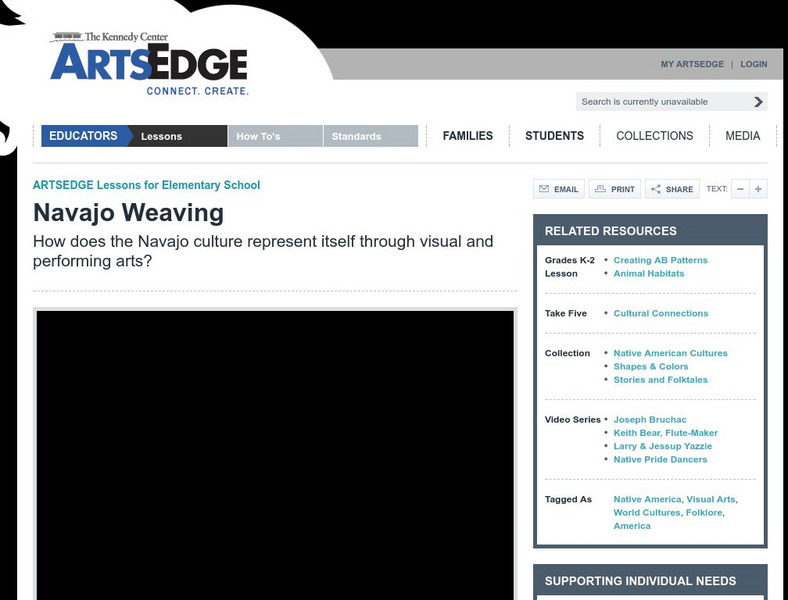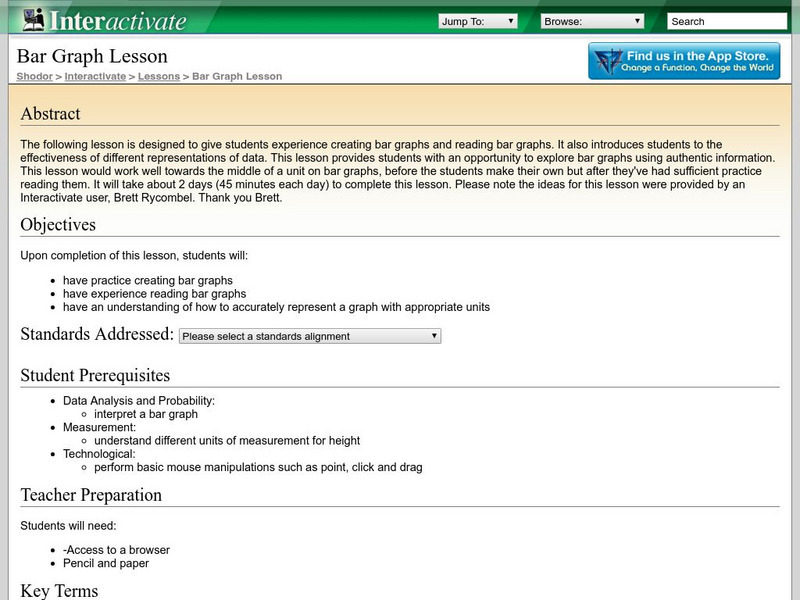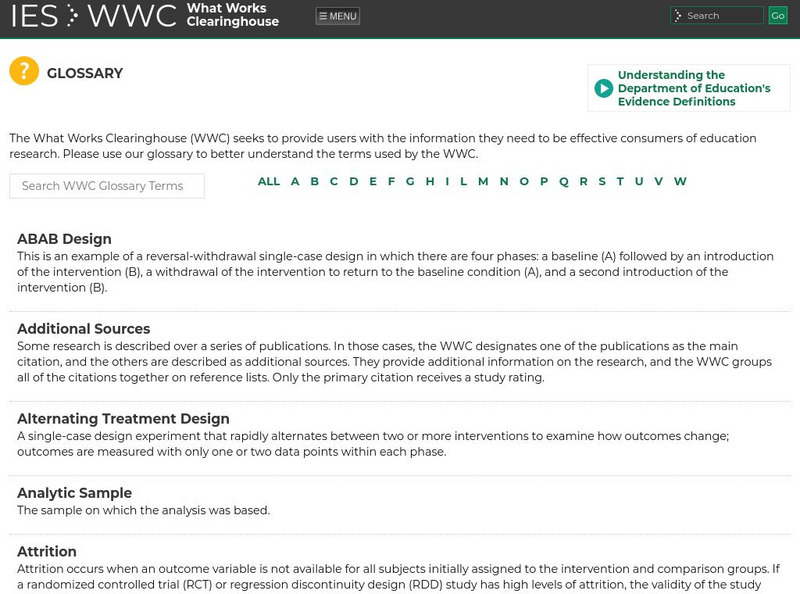John F. Kennedy Center
The Kennedy Center: Masks and Aesop's Fables
This multi-media visual and language arts lesson plan offers intellectual, creative, and interpretive opportunities through use of books, music, and the internet. It offers complete grade-leveled lesson plans for grades k-4 which include...
John F. Kennedy Center
The Kennedy Center: Lesson: Navajo Weaving
Intergrating dance into your social studies lesson on the Navajo culture will give your students a glimpse into another way of life. They will use their knowledge of loom weaving, Native Americans, and creative dance to express these...
John F. Kennedy Center
The Kennedy Center: Brass Instruments and Pitch
Students will enjoy making their own brass instrument with this interesting lesson plan. Objectives include what factors affect the pitch of brass instruments and what determines pitch.
John F. Kennedy Center
The Kennedy Center: Lesson: A Listening Doll
In this lesson plan, students explore the tradition of Pueblo "Listening dolls" and create their own version of this historical tradition. Also contains a rubric, extensions, and books to use as references.
John F. Kennedy Center
The Kennedy Center: Arts Edge: Navajo Weaving
After studying Navajo weaving and listening to the story "Ten Little Rabbits," learners create their own interpretive dances. Contains an assessment checklist and extensions ideas.
PBS
Pbs Learning Media: Seven Selfish Shellfish
This video segment from Between the Lions features a classic tongue twister: a type of wordplay that helps children tune their ears to language and the sounds within words. [0:29]
PBS
Pbs Learning Media: Bird Food and Bird Beaks
There are almost as many types of bird beaks as there are types of food that birds like to eat. This collection of images shows a wide range of beaks and the types of foods handled by each.
Shodor Education Foundation
Shodor Interactivate: Lesson: Bar Graph
This lesson is designed to give students practice creating and reading bar graphs as well as understanding how to accurately represent a graph with appropriate units.
Environmental Education for Kids
Eek!: Canada Goose
Read all about Canadian geese at this fun and interesting site! What do Canadian geese look like? How do they behave? Where do they live? Learn the answers to all of these questions, and more!
US Department of Education
U.s. Department of Education: Institute of Education Sciences: Glossary
A glossary of words commonly encountered when reading about educational research. Either scroll through the complete list or go to a specific letter, then click on the word and a definition will be provided.
PBS
Pbs Learning Media: Classroom Tips
From managing the technology to tips for transporting video files, this resource offers practical advice and strategies for video use.
Science Buddies
Science Buddies: Project Ideas: How Much Water Is Absorbed by Dried Beans?
In this cooking and food science fair project, measure how the water content of dried beans changes with time. The Science Buddies project ideas are set up consistently beginning with an abstract, objective, and introduction, followed by...
Science Buddies
Science Buddies: Project Ideas: Pet Poll: A Taste Test for Fluffy and Fido
In this mammalian biology science fair project, students will determine which brand, type, or flavor of treats their pet prefers. The Science Buddies project ideas are set up consistently beginning with an abstract, objective, and...
Science Buddies
Science Buddies: Are You in Hot Water? Use Solar Energy to Heat Your Own Water
The goal of this science fair project is to build batch solar collectors from different colors of plastic bags and see which collector is the most efficient in heating water.
Science Buddies
Science Buddies: Project Ideas: Whirl Y Bird vs. Whale Y Bird
Improve the design of a very simple aircraft, the whirlybird, and learn about hydrodynamics and biomimicry in this science experiment. The Science Buddies project ideas are set up consistently beginning with an abstract, objective, and...
Science Buddies
Science Buddies: The Bouba Kiki Effect
It may be possible for certain symbolic characteristics, like sharpness and roundedness, to cross language barriers. For this experiment you will investigate the Bouba-Kiki Effect to find out if abstract visual properties can be linked...
PBS
Pbs Kids: Super Why: Princess Presto Spectacular Sounds Bingo
In this bingo game, listen for the sounds of the letters and click on the correct letter; when you have completed all the letters, a picture is revealed.
Chase Young, PhD
Dr. Chase Young, Ph D: Reader's Theater Script: Arthur's Christmas [Pdf]
A reader's theater script for Marc Brown's children's book, Arthur's Christmas, is provided on these pages. Ten character roles are needed in this activity.
Chase Young, PhD
Dr. Chase Young, Ph D: Reader's Theater Script: Jack, the Cunning Thief [Pdf]
A reader's theater adaptation of the Celtic fairy tale, Jack, the Cunning Thief, is provided on this script. Seventeen character roles are needed in this performance.
Chase Young, PhD
Dr. Chase Young, Ph D: Reader's Theater Script: The Three Little Wolves and the Big Bad Pig [Pdf]
A reader's theater script for Eugene Triviza's children's picture book, The Three Little Wolves and the Big Bad Pig, is provided on these pages. Fifteen character roles are needed in this activity.
BioEd Online
Bio Ed Online: Living Things and Their Needs: Need or Want?
Students learn the difference between wanting something and needing something in order to survive. The lesson can be downloaded in PDF format.
BioEd Online
Bio Ed Online: Resources and Animals
In this lesson plan students will observe, examine, discuss and draw a walking stick insect or acrawfish in its natural environment in order to understand resources and animals.
BioEd Online
Bio Ed Online: Raw vs. Processed Food
In this lesson students will gain an understanding of what "processed" means. They will also distinguish between natural and processed foods, and learn about sources of some foods.
BioEd Online
Bio Ed Online: Making a Water Cycle
In this lesson students are required to observe a simple model of the water cycle constructed of sand and ice in a plastic shoe box.


















